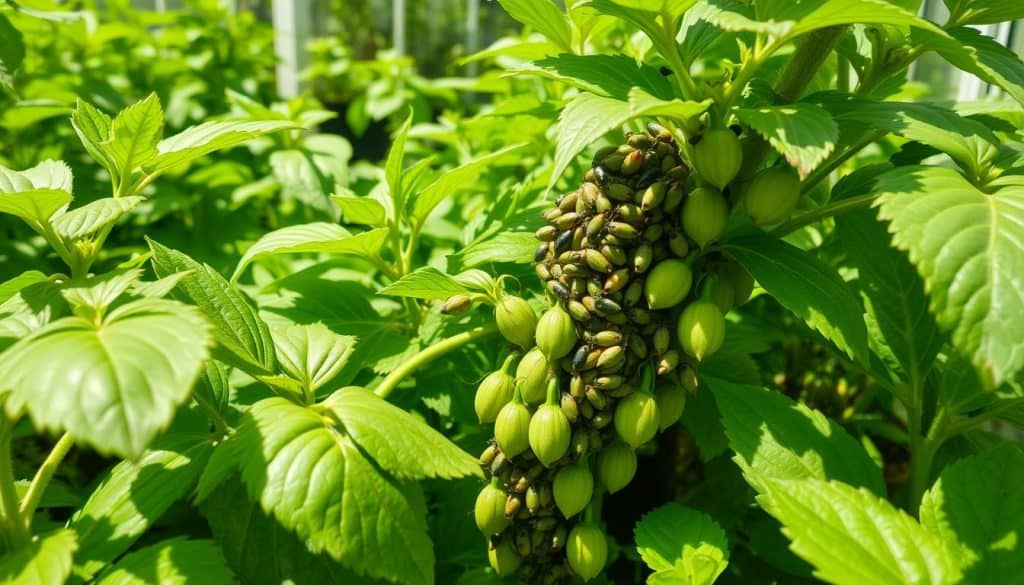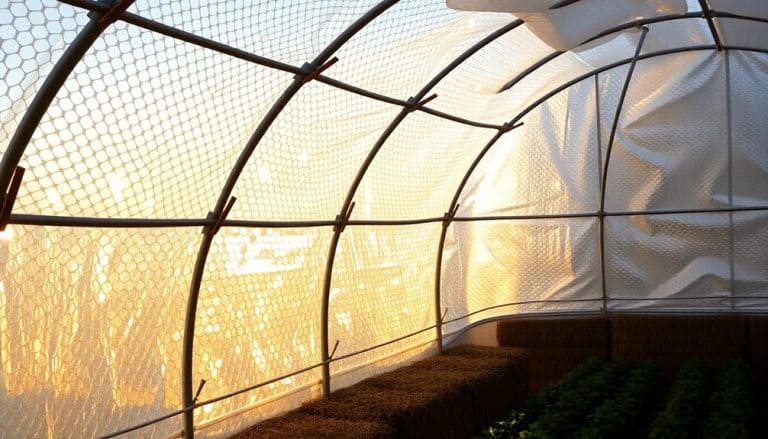This website contains affiliate links. Some products are gifted by the brand to test. As an Amazon Associate, I earn from qualifying purchases. The content on this website was created with the help of AI.
Three key factors cause 95% of greenhouse pest outbreaks. This fact highlights the need for integrated pest management in greenhouses. Let’s explore these factors and their importance in pest control and disease prevention.
Pests and diseases constantly threaten greenhouse plants. They can easily disrupt the delicate greenhouse ecosystem. This disruption can lead to severe crop damage.
Effective pest control isn’t just about reacting to problems. It’s about creating an environment where pests struggle to thrive. This approach is the core of integrated pest management.
This strategy looks at all aspects of plant health. It also considers environmental conditions. By focusing on prevention, we can keep plants healthier.
Early detection allows for targeted interventions. This reduces the need for harsh chemicals. As a result, we can create more sustainable greenhouse operations.
Key Takeaways
- Three main factors contribute to 95% of greenhouse pest outbreaks
- Integrated pest management is crucial for effective greenhouse control
- Prevention strategies are more effective than reactive treatments
- Early detection allows for less invasive control measures
- Sustainable pest management leads to healthier plants and better yields
- Regular monitoring and proper environmental control are essential
Understanding Greenhouse Pest Management Fundamentals
Effective greenhouse pest management is vital for plant health. Key factors include pest outbreaks, environmental conditions, and plant susceptibility. Let’s explore these elements to help protect your crops.
Key Factors in Pest Outbreaks
Pest outbreaks can devastate greenhouse crops. Aphids multiply fast – two on Monday can become 100 by Friday. Regular greenhouse scouting helps catch issues early.
Role of Environmental Conditions
Environmental factors greatly influence pest growth. Monitoring root zone moisture, pH, and temperature is essential. Some growers explore UV light effects on crops for pest control.
| Environmental Factor | Impact on Pest Management |
|---|---|
| Root Zone Moisture | Affects pest habitat and plant stress |
| pH at Root Zone | Influences nutrient availability and pest resistance |
| Temperature | Determines pest lifecycle and reproduction rates |
Plant Host Susceptibility
Plant susceptibility to pests varies widely. Research on symbiotic endomycorrhizae and microbiome mapping improves our understanding of plant-pest interactions. Organic materials like humic acid in seed coatings can boost plant resilience.
Understanding these basics helps improve pest management strategies. Regular greenhouse scouting is crucial. These practices maintain optimal plant health in greenhouses.
Essential Prevention and Biosecurity Measures
Strong prevention and biosecurity measures protect greenhouse crops. These steps keep pests and diseases away. They ensure healthy plant growth.
Installing Protective Barriers
Physical barriers prevent pest entry. Place insect screens on air intakes. Set up airlocks at entry points.
A plant-free strip around the greenhouse stops infestations. Insect screens can also prevent outside pests from entering.
Greenhouse Sanitation Protocols
Sanitation is crucial for disease prevention. Start with disease-free plants and inspect them upon delivery. Regular cleaning reduces disease losses significantly.
Proper waste management stops disease buildup. Remove crop residues quickly to prevent issues.
- Use footbaths at entrances
- Wear clean clothes and protective gear
- Remove all weeds inside and outside
- Disinfect tools, carts, and crates daily
Climate Control Strategies
Managing the greenhouse environment controls pests and diseases. Adjust temperature, humidity, and air circulation. This creates unfavorable conditions for pests.
This approach works well against Powdery Mildew and Botrytis. It’s an effective part of pest management.
These measures create a strong defense against pests and diseases. Regular monitoring and quick action complete our greenhouse management approach.
Controlling Pests and Diseases in a Greenhouse
Greenhouse success relies on effective pest and disease management. We use integrated pest management and select greenhouse pesticides carefully. This approach blends cultural, biological, and chemical methods to keep plants healthy.
Regular monitoring is essential for early pest detection. We place sticky cards at canopy level every 2000-4000 ft². Quick action with targeted treatments helps prevent crop yield losses.
Biological controls are a key part of our strategy. We use Encarsia formosa wasps to manage whiteflies. These tiny helpers can reduce whitefly populations significantly in a short time.
Reflective mulch also helps confuse aphids and reduce infestations. This simple method can cut aphid problems by more than half.
We apply greenhouse pesticides carefully when needed. Spot treatments are preferred over blanket spraying to protect beneficial insects. This approach cuts chemical use by 40%.
We rotate pesticides to prevent resistance. Different mode of action groups like 4A (neonicotinoids) and 3A (pyrethroids) are used.
Our integrated approach creates a balanced greenhouse ecosystem. It protects crops and ensures sustainable, long-term pest management.
Early Detection and Monitoring Systems
Greenhouse scouting is crucial for integrated pest management. We’ll explore key strategies to catch pest issues early. These methods help prevent problems from getting out of hand.
Sticky Card Placement and Usage
Yellow sticky cards track flying pests effectively. Place one card per 1,000 square feet in a grid pattern. Check cards weekly, or every three days for extra caution.
Use a 5X to 10X hand lens to spot tiny insects. This helps identify pests accurately and quickly.
Regular Plant Inspection Methods
Inspect plants thoroughly every week or twice a week. Spend 10 minutes examining 20+ plants per 1,000 square feet. This hands-on approach helps spot non-flying pests and early disease signs.
Use colored tape to mark problem areas. This makes tracking and follow-up easier for your team.
Digital Monitoring Tools
Digital tools boost our pest management efforts. Smartphone apps help identify pests quickly. Automated sensors track temperature and humidity in real-time.
These tools alert us to conditions that favor pest outbreaks. This allows for quick action to prevent problems.
| Monitoring Method | Frequency | Target Pests |
|---|---|---|
| Sticky Cards | Weekly | Whiteflies, Thrips, Fungus Gnats |
| Visual Inspection | Twice-weekly | Aphids, Spider Mites, Disease Symptoms |
| Indicator Plants | Daily | Various Pests, Early Detection |
| Digital Sensors | Continuous | Environmental Conditions |
Combining these methods creates a strong early detection system. This proactive approach helps address pest issues quickly. It keeps plants healthy and reduces the need for harsh chemicals.
Common Greenhouse Insect Pests
Keeping greenhouse pests in check is key to a thriving plant environment. Various insects can damage our crops. Let’s look at some common pests and their traits.
Aphids are tiny sap-suckers that multiply fast. They can produce up to 10 live young daily. Their life cycle lasts only 20-30 days.
Whiteflies and thrips also feed on plant sap. Thrips leave black fecal specks and can spread viruses. Spider mites spin webs and cause leaf damage.
Fungus gnats and shore flies love damp spaces. Fungus gnats complete their life cycle in about 20 days. Shore fly larvae can grow to 1/4 inch and eat algae.
| Pest | Characteristics | Control Methods |
|---|---|---|
| Aphids | Rapid reproduction, live birth | Insecticidal soaps, natural predators |
| Whiteflies | Sap-feeding, leaf damage | Sticky traps, neem oil |
| Thrips | Virus vectors, black fecal specks | Beneficial nematodes, insecticidal soaps |
| Spider Mites | Web-spinning, leaf stippling | Predatory mites, humidity control |
| Fungus Gnats | Moist media, 20-25 day life cycle | Soil drying, sticky cards |
Good pest control needs prevention, watching, and targeted treatments. A strong pest management plan helps plants thrive. It keeps common pests away and ensures healthy growth.
Managing Aphid Infestations
Aphids are tiny pests that cause big problems in greenhouses. They multiply fast, making them hard to control. Let’s learn how to spot and deal with these pesky insects.
Identification Characteristics
Aphids are small bugs, less than 1/8 inch long. They have special tubes on their backs and come in many colors. Female aphids can have 60-100 babies in just one month.

Natural Control Methods
Using nature’s helpers is a great way to manage aphids. Ladybugs, lacewings, and wasps eat aphids and keep them in check. Regular checks and good greenhouse care are key to success.
Chemical Treatment Options
Sometimes, natural methods aren’t enough to stop aphids. Insecticidal soaps and oils are safer options for treatment. For big problems, stronger chemicals might be needed.
Always switch up the products you use. This stops aphids from getting used to one type.
| Control Method | Effectiveness | Environmental Impact |
|---|---|---|
| Biological Control | High | Low |
| Insecticidal Soaps | Moderate | Low |
| Systemic Insecticides | High | Moderate |
Good aphid control means using different methods together. Mix natural and chemical ways to beat aphids. This keeps your greenhouse healthy without hurting the environment too much.
Whitefly Control Strategies
Whiteflies are a major pest in greenhouses. They attack over 250 plant types, including veggies and flowers. Greenhouse and sweet potato whiteflies are common troublemakers.
For effective control, we suggest a multi-pronged approach. Install insect screens and keep your greenhouse clean. Use yellow sticky cards to spot infestations early. Take action when you see five whiteflies on these cards.
Integrated pest management works well against whiteflies. Try water sprays and vacuuming to reduce their numbers. Insecticidal soaps and oils are good chemical options. For houseplants, SunSpray oil is great when diluted.
Biological control is also powerful. Parasitic wasps like Encarsia formosa can keep whiteflies in check. These helpers work best at 70-80°F and 50-80% humidity.
Whiteflies can complete their lifecycle in 21-36 days. Each female lays up to 400 eggs. This fast breeding makes quick, thorough control crucial in greenhouses.
Spider Mite Management Techniques
Spider mites are a big problem in greenhouse pest control. They multiply fast and damage crops. Let’s look at ways to manage these tiny pests.
Prevention Methods
Stopping spider mites before they start is key. Keep humidity right and plants healthy. Water often to cut down on dust mites like.
Be careful with insecticides. They can kill helpful bugs and cause more mite problems.
Biological Control Options
Using other bugs to fight spider mites works well. Persimilis and Swirski mites are great choices. Persimilis likes temps between 55°F and 85°F.
Swirski mites do best above 68°F. Use one good mite for every ten bad ones.

Treatment Protocols
Act fast if you see mites. Clean webs with soapy sponges and spray water to knock mites off. Try insecticidal soaps or oils first.
Use stronger mite killers only if you must. These can hurt helpful bugs too.
| Spider Mite Species | Preferred Conditions | Common Hosts |
|---|---|---|
| Twospotted spider mite | Hot, dry conditions | Various crops |
| Spruce spider mite | Cool temperatures | Spruce, arborvitae, juniper |
| Southern red mite | Moderate temperatures | Ornamental plants |
These tips can help you control spider mites in greenhouses. Catch them early and use different methods together.
This approach keeps crops healthy and saves money.
Fungus Gnat and Shore Fly Control
Greenhouse pest control requires managing fungus gnats and shore flies. These pests love moist environments, making greenhouses perfect breeding spots. Fungus gnats lay up to 300 eggs in clusters.
Their larvae feed for 12-14 days before pupating. Shore flies are less harmful to plants. However, they signal too much moisture and algae growth.
An integrated pest management approach works best for these pests. First, reduce excess moisture in growing media. Also, eliminate standing water. These steps can greatly decrease their numbers.
Use yellow sticky cards for fungus gnats and blue ones for shore flies. Place about 10 traps per 1000 square feet. This helps monitor pest populations effectively.
Consider using Bacillus thuringiensis israelensis before fungus gnat populations peak. Biological control options include predaceous mites, parasitic nematodes, and rove beetles. Chemical treatments like insect growth regulators can help too.
Be careful with chemicals as they may harm plant roots or helpful insects. Prevention is crucial in greenhouse pest control. Regular inspections and proper sanitation are key.
Maintain optimal growing conditions to keep these pests away. Combining these strategies creates a strong defense against fungus gnats and shore flies. This approach ensures a healthier greenhouse environment.
Integrated Disease Management Approaches
Healthy plants need good greenhouse disease prevention. We use integrated pest management to control pests and diseases. This combines cultural, chemical, and environmental methods for a complete strategy.
Cultural Control Methods
Cultural controls are key in our pest management program. We space plants properly to improve air flow and lower humidity. Regular cleaning, including removing dead plants and disinfecting tools, prevents disease spread.
We also choose disease-resistant plant varieties. This helps reduce the need for other control methods.
Chemical Control Options
We use chemical controls carefully when needed. We rotate different pesticides to prevent resistance. Bio-insecticides with special fungi or bacteria are our top choice.
These often work with organic farming rules. This approach has helped us avoid resistant thrips and spider mites.
Environmental Management
Managing the greenhouse environment is vital for stopping diseases. We control temperature, humidity, and air flow to discourage disease growth. Yellow sticky cards throughout the greenhouse help us track pests.
We check about 20 plants per 1,000 square feet each week. This regular scouting helps us catch problems early.
| Control Method | Examples | Benefits |
|---|---|---|
| Cultural | Proper spacing, sanitation, resistant varieties | Reduces disease spread, improves plant health |
| Chemical | Bio-insecticides, pesticide rotation | Targets specific pests, prevents resistance |
| Environmental | Temperature control, humidity management | Creates unfavorable conditions for diseases |
Our combined approach has cut down our use of harsh pesticides. We still maintain effective greenhouse disease prevention. This strategy protects our plants and supports a healthier greenhouse ecosystem.
Biological Control Agents and Their Implementation
Biological control in greenhouses is gaining popularity. Growers are using it as part of pest management strategies. This shift reduces pesticide use and boosts sustainability reputation.
Various biological control agents exist. These include predatory insects, parasitic wasps, and beneficial microorganisms. Ladybugs fight aphids, while parasitic wasps target whiteflies. Predatory mites help manage spider mites.
Natural enemies fall into four main groups. These are predators, parasites, parasitoids, and pathogens. Each group plays a unique role in pest control.
Implementing biological control needs careful planning. It works best when used early or preventatively. While challenging, it offers long-term environmental benefits.
In the U.S., greenhouse vegetable production is growing fast. Biological control is becoming a cost-effective alternative to chemicals. It’s particularly important for high-value crops in greenhouses.
Combining biological control with other pest management techniques is often successful. The U.S. floriculture and nursery industry is booming. Sales have reached $11.7 billion. This growth highlights the importance of biological control.




